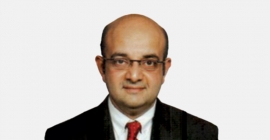‘Digital formats are making OOH more effective’
By Rajiv Raghunath - December 20, 2018
Nick Mawditt, Managing Partner of UK-based OOH media specialist Talon Outdoor, shares his perspectives on the impact of digital OOH on the OOH industry’s growth trajectory
 Digital OOH is one of the fastest growing media channels in the UK? Is this growth spurred by existing advertisers increasing their OOH spends, or new advertisers gravitating to the medium in the wake of digitalisation of OOH?
Digital OOH is one of the fastest growing media channels in the UK? Is this growth spurred by existing advertisers increasing their OOH spends, or new advertisers gravitating to the medium in the wake of digitalisation of OOH?
Digital OOH has grown through taking a different approach. Existing advertisers have approached OOH in a more contextual way and new advertisers have realised they can achieve the flexibility they get in other channels. Big brands like McDonald’s have used digital OOH to advertise a broader product range and more circumstantial messaging. Meanwhile, the likes of Virgin Holidays, Starbucks and others like Cunard have used a more tactical approach through integrating their online digital offer or using full motion or influencer marketing with digital OOH. Either way, the investment coming into the medium with millions being spent across all environments, is transforming OOH into something much more aligned to the changing media marketplace.
As DOOH networks expand, what will be the net impact on OOH media planning and buying?
We’re seeing greater consolidation in the UK market and the strongest players driving huge investment. So whether JCDecaux creating digital roadside, mall or rail transport networks, or brands like Ocean Outdoor and Clear Channel strengthening their networks in retail, city centre or roadside locations, this is enabling more audience and true location planning.
Investments are bringing networks to larger audiences and enhancing OOH’s ability to drive reach. We’ve seen a more effective medium emerge as a result and according to major studies, data is now opening more location opportunities and planning using more flexibility with share of time factors and longer durations, smarter optimisation and more enhanced targeting are more commonplace.
You have stated some time ago that ‘content has found a natural home in digital OOH’. Are brands using content effectively to get the best outcomes from DOOH media?
Content is one of digital OOH’s untapped opportunities to connect with brands. Not many advertisers are using content in OOH today but this is fast changing. Some, like leading commercial broadcaster ITV, are using screens to broadcast live sports. Otherwise, fashion and travel brands have used screens in city centres and the London Underground to drive a new kind of engagement.
Piccadilly Lights - the UK’s most famous digital screen - has transformed and brands like Victoria Beckham have used live content. Others have adopted brand advertising that simply looks more content led and dynamic (the advantage of full motion) compared to conventional OOH
More recently, you have cited how full motion DOOH (FMDOOH) can be used to amplify social media campaigns. Are you seeing this synergy happening in the UK markets?
Very much so and advertisers are realising that in light of brand safety and accountability issues affecting social and online comms, digital OOH can offer far more accountable and dynamic advertising that is reaching more audience. We are seeing brands connect their social video and influencer marketing content with full motion digital OOH. Talon’s recent 4th Space research shows an overwhelmingly positive and powerful impact with full motion OOH driving even greater consideration, emotional response and sales actions when alongside social video. It is reimagining OOH.
As the OOH industry embraces data technologies, do you see the industry also enhancing its competitiveness vis-à-vis other media channels and thereby gain a greater share of the advertising pie?
Absolutely. Part of the transformation is happening in automation as we move towards greater planning and buying efficiencies. But the real change is happening in the application of location data, enabled by technology and access. The availability of more complex location data is enabling smarter and more targeted planning combined with the seamless measurement of outcomes. Our recent case study you referenced with McDonald’s highlights the new and emerging capabilities of OOH. The real benefit lies in securing advertiser confidence that sales, footfall and other key brand metrics can be delivered and measured by OOH, reflecting the core values of branding, reach and proximity location planning; proximity to stores but most importantly to audiences. Technology is enabling us to hit the sweet spot and for those more mobile audiences the combination of device data, location planning technology and data such as Route and other third party sources are key drivers for success.
Would brands that have been advertising on classic large formats see value in using digital placed-based media, or would they look for only large format digital display options?
Is DOOH media helping the industry to improve its media monitoring and accountability standards? Are brands better served through use of digital media?
More advertisers are using a range of formats. Place based formats and environments --traditionally used to drive activation -- have improved aesthetically and in their ability to reach larger audiences. Now, full motion capabilities are equally adept at driving emotional factors and branding. Audiences in those environments are more receptive to branding messages, whether in the relaxed shopper mindset or as a commuter actively planning and researching future behaviours. Those who previously used large format OOH are seeking ways to maximise the combination of classic and digital OOH to ensure greatest effect. In light of a 50% reduction in paper sheets in the UK in five years, the smart advertisers are using a balance of formats to maximise reach, impact and integrated planning. Those not embracing digital in this way are getting left behind.
Those seeing the fuller picture are embracing motion, context and flexibility around time to ensure they are always on. Large format digital is now achieving reach and impact across an increasing number of UK towns and cities but it is the audience composition and location and not merely the formats that drive success.
Is DOOH media helping the industry to improve its media monitoring and accountability standards? Are brands better served through use of digital media?
A constant challenge across media but real progress has been made in this space and it remains crucial for all digital media owners to continue to drive this area. The work conducted by the industry through Route and Space initiatives plus individual media owner investment and specialist agencies ensuring development, open access APIs and full accountability to clients is crucial for digital OOH to continue to stand apart from the fraud and brand safety issues that the industry faces over digital online.

Stay on top of OOH media trends









